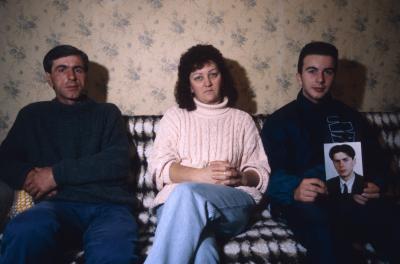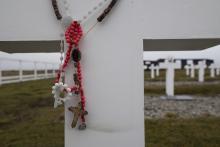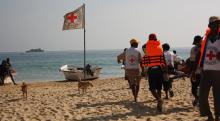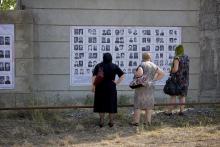Basic international humanitarian law (IHL) rules applicable to this situation:
Whenever possible, and particularly after an engagement, each party to the conflict must, without delay, take all possible measures to search for, collect and evacuate the dead without adverse distinction.
Parties to the conflict must endeavour to facilitate the return of the remains of the deceased upon request of the party to which they belong or upon the request of their next of kin.
The dead must be disposed of in a respectful manner and their graves respected and properly maintained.
To facilitate identification of the dead, each party to the conflict must record all available information prior to disposal and mark the location of the graves.
Each party to the conflict must take all feasible measures to account for persons reported missing in connection with armed conflict and must provide their family members with any information it has on their fate.
The case in brief
In 1991–1995, armed conflict in the former Yugoslavia resulted in thousands of people unaccounted for, causing profound suffering for their families.
With support from the relatives of the missing and relevant organizations (e.g., the ICRC, the International Commission on Missing Persons), the Croatian authorities succeeded in clarifying what had happened to the majority of people who went missing on the territory of the Republic of Croatia in connection with the conflict. Their actions, demonstrating compliance with IHL, may have contributed to healing some of the trauma caused by the conflict.
IHL compliance highlights
- Following Croatian military operations in 1995, the Croatian authorities collected the dead, taking care to photograph, record and bury the remains appropriately.
- Subsequently, the Croatian authorities took numerous steps to clarify what happened to people unaccounted for, including:
- establishing a commission and state department dedicated to resolving cases of missing people in cooperation with their relatives and relevant governments and organizations
- establishing an electronic database containing all relevant data
- in 2014, alongside other parties to the conflict, formally acknowledging the state’s responsibility to address the issue of the missing.
- Between 1995 and 2016, the Croatian authorities exhumed 5,077 bodies, of which 4,163 had been identified.
Case prepared by Jasmine Nicolson and Adinda van de Walle, LL.M. students at Leiden University, under the supervision of Professor Robert Heinsch as well as Sofia Poulopoulou (PhD researcher), Johanna Trittenbach and Mahan Charmshir (research assistants), Kalshoven-Gieskes Forum, Leiden University, and Abdul Aziz, Ana Paula Vargas Rodrigues, Bethania Godinho, Mozna Abumery, and Sarawut Theerakul, students from the NOHA Master, Institute for International Law of Peace and Armed Conflict (IFHV), Ruhr-University Bochum, under the supervision of Professor Robert Heinsch and Dr. Valentina Azarova.
A. JOINT PROJECT ON DNA-LED IDENTIFICATIONS BETWEEN CROATIA AND THE INTERNATIONAL COMMISSION ON MISSING PERSONS
[Source: ICMP, Joint Project on DNA-led Identifications between the Ministry of the Family, Veterans' Affairs and Intergenerational Solidarity of the Republic of Croatia and the International Commission on Missing Persons, November 2004, available at https://www.icmp.int/wp-content/uploads/2004/11/join-project-icmp-roc-for-the-web.pdf]
1. CONTEXT
The issue of missing persons from the recent armed conflict continues to cause suffering for the individual relatives of the missing, as well as creating impediments to societal progress. With this premise in mind, the International Commission on Missing Persons (“ICMP”) and the Ministry of the Family, Veterans' Affairs and Intergenerational Solidarity of the Government of the Republic of Croatia (“the Ministry”) will embark upon the implementation of a Joint Project to enable the resolution of increased numbers of missing persons’ cases stemming from the recent conflicts.
The Joint Project between the Ministry and ICMP concerns efforts to identify the mortal remains of persons unaccounted for as a result of the armed conflicts in countries created on the territory of the former Yugoslavia.
[...]
2. OBJECTIVE
The objective of the project is to jointly resolve outstanding cases of missing persons through the use of a DNA-led system of identifications. The project entails the appropriate exchange of STR profiles between the Ministry and ICMP (“the Parties”) relevant to missing persons’ cases in an effort to produce DNA reports that will lead to identifications. The exchange of data will allow for joint utilisation of ICMP DNA matching software, to which the ICMP agrees to provide access to the Ministry, as well as any required training for its use. The Joint Project also includes the collection of blood samples for DNA testing […].
B. MISSION OF THE UN WORKING GROUP ON ENFORCED OR INVOLUNTARY DISAPPEARANCES TO CROATIA
[Source: UNHRC, Report of the Working Group on Enforced or Involuntary Disappearances, Mission to Croatia, §§15, 21-24, 33-34, 37-38, 17 August 2015, available at: https://undocs.org/A/HRC/30/38/Add.3]
[…]
15. […] The Working Group was pleased to learn that, on 29 August 2014, Bosnia and Herzegovina, Croatia, Montenegro and Serbia, signed the Declaration on the Role of the State in Addressing the Issue of Persons Missing as a Consequence of Armed Conflict and Human Rights Abuses. The Working Group welcomes this initiative, which highlights the primary responsibility of States in addressing the issue of missing persons, with the aim of guaranteeing the rights of victims. The Declaration also stresses the need for cooperation between Governments and with international and other organizations in the process of establishing the whereabouts of the missing persons. […]
[...]
21. The Government of Croatia established the Commission on Detainees and Missing Persons as an advisory and expert interdepartmental body of the Croatian Government to give opinions, proposals and expert explanations on issues relating to missing persons. […]
22. The Directorate for Detained and Missing Persons in the Ministry of Veterans’ Affairs is in charge of collecting data on all persons who went missing during the war. It performs all the expert and administrative tasks related to the search for missing persons, including exhumations and identification of human remains. […]
23. The Directorate for Detained and Missing Persons also organizes burials of identified victims, according to the wishes of the family regarding the type, place and time of the ceremony. The Directorate cooperates with all governmental institutions, international organizations and civil society associations that are working on the issue of missing persons.
24. Enforced disappearances occurred on the territory of the Republic of Croatia, particularly at the beginning and the end of the conflict. Most of the Croat victims were disappeared in 1991, while most of the Serb victims were disappeared in 1995, during the Flash and Storm military operations. According to information from the Ministry of Veterans’ Affairs, 18,000 individuals disappeared in 1991 and another 1,226 disappeared in 1995.
[...]
33. The Working Group notes that there has been significant progress in the process of exhumations and identifications of disappeared and missing persons. Since 1995, 148 mass graves and 1,200 individual graves have been identified by the Croatian authorities. Human remains of conflict victims have also been found at 14 registered graves sites. After the Flash and Storm military operations, the Croatian authorities collected all the dead bodies in the affected areas. The remains were photographed, recorded and buried in or near a cemetery, in accordance with the Geneva Conventions relating to the protection of victims of international armed conflicts and the Additional Protocols thereto.
34. Up to the date of the Working Group’s visit, a total of 4,942 bodies had been exhumed, of which 3,979 had been identified. That includes the remains of 1,007 individuals that were exhumed from registered grave sites since 2001 under the supervision of the Directorate for Detained and Missing Persons. The Working Group notes that 80.5 per cent of the exhumed bodies have been identified (85 per cent from 1991/1992 and 62 per cent from 1995). The identification rate for the 1995 cases is lower owing to the fact that the relatives of the persons who went missing in 1995 do not live in Croatia and therefore may not have provided blood samples for the relevant database of the Croatian authorities. [...]
[…]
37. The Working Group notes that families and representatives of institutions responsible for searching for disappeared persons from the Republic of Serbia and from Bosnia and Herzegovina are invited to be present during the exhumations if it is felt that their presence can contribute to ascertaining the fate or whereabouts of disappeared persons who are in some way related to those countries. The Red Cross of Croatia also has a significant role in the process of the searching for, exhumation and identification of missing persons in the Republic of Croatia.
38. The Working Group notes that an electronic database of missing persons that contains all the relevant data regarding missing persons, including ante-mortal data, has been established.
[…]
C. ACCOUNTING FOR MISSING PERSONS: 1995-2016
[Source: ICMP, “Missing Persons from the Conflict in Croatia”, February 2017, available at https://www.icmp.int/news/missing-persons-from-the-conflict-in-croatia]
[…]
ICMP’s role in accounting for the missing from the armed conflict in Croatia has been to ensure an impartial, non-discriminatory process so that missing persons are searched for and identified regardless of ethnicity, nationality, or religion and regardless of the victim’s role, either as a combatant or a civilian, or allegiance. ICMP has moreover encouraged the Croatian authorities to use modern forensic methods, including DNA testing and data systems, as the optimal way of identifying the missing and protecting the rights of surviving families.
[…]
According to the Croatian Directorate of Detained and Missing, more than 6,000 people were unaccounted for as a result of the 1991-1995 conflict in Croatia. The Directorate reports that between 1995 and December 2016, 5,077 bodies were exhumed and 4,163 identified (please see Table 1 below).
[…]
Cooperation with ICMP
[…] ICMP has contributed to Croatia’s identification efforts with donations, expertise, support to victims’ groups and the monitoring of exhumations. This has included the donation of a fluoroscope in 1999, DNA-processing equipment in 2000 and financial support for the renovation of a DNA laboratory in Zagreb in 2001, as well as providing training to improve operating techniques in Croatia’s three DNA laboratories. […]
D. BOOK OF MISSING PERSONS ON THE TERRITORY OF CROATIA
[Source: ICRC, “Book of Missing Persons on the Territory of the Republic of Croatia 4th Edition”, May 2015, available at: Link not available.]
[...]
The issue of persons who went missing during the conflict in the Republic of Croatia is one of the most important humanitarian questions stemming from the conflict. The fate of the majority of persons who went missing on the territory of the Republic of Croatia has been clarified thanks to the work of the responsible state institutions headed by the Administration for Detained and Missing of the Ministry of Veterans, the International Committee of the Red Cross, Tracing Service of the Croatian Red Cross and numerous National Societies and other partners of the International Red Cross and Red Crescent Movement. However, a number of families have still not fulfilled their basic human and humanitarian right – to know the truth about what happened to their beloved.
The Book of Missing Persons on the Territory of the Republic of Croatia is being published with the aim to assist the family members of missing persons to fulfil their right to know the truth about the fate of their dearest ones. The Book is also an appeal to the public to contribute with findings and information in their possession to the process of search and clarification of the fate of missing persons, as well as to sensitize the society with regard to the continued existence of this problem that relentlessly hampers the healing of the war trauma. The Book is also a tool in the search process that demonstrates a continuous commitment and efforts of the responsible state institutions and international and humanitarian organizations in their desire to reach the final resolution of the issue of missing persons.
[...]
Discussion
I. Classification of the Situation and Applicable Law
1. How would you classify the situation in Croatia between 1991-92 and in 1995? Was there an armed conflict? If so, who were the parties to the conflict? What additional information would you require to make this determination? (GC I-IV, Arts 2, 3; P I, Art. 1; PII, Art. 1)
II. Clarifying the Fate of Missing Persons and Accounting for the Dead
2. What are the obligations of the parties to the conflict with regard to the search of missing persons? (PI, Art.33)
3. What rights do the families of the missing have under IHL? Do they have a right to know the fate of their loved ones? (PI, Art. 32; CIHL, Rule 117)
4. What are the State obligations with regard to the dead? How shall the remains of the deceased be disposed of? To whom does it have to return the remains? Are the relevant rules also applicable in non-international armed conflicts? (GC I, Arts 15, 16, 17; GC III, Art. 120; GC IV, Arts 16, 129, 130; PI, Art. 34; PII, Art. 8; CIHL, Rules 112, 113, 114, 115, 116)
5. Is the nationality of the persons missing a relevant aspect for consideration under IHL? Can the Serbians that went missing in the territory of Croatia be considered protected persons under the Geneva Convention IV? Could ethnicity replace the requirement of nationality? (GC IV, Art 4)
III. Elements Contributing to Respect for IHL
6. (Documents A, B, D) How do families play an important role in the process of clarification of the fate of missing persons? Why is it so crucial for the families to get information about missing persons? How does pressure by families influence State action?
7. (Document D) What is the value of sensitizing society about the issue of missing persons? How do the unresolved cases of missing persons impede the healing of the ‘war trauma’? Is this also a factor that influence the States to act in accordance with IHL?
8. (Document B) What is the role of the UN Working Group on Enforced or Involuntary Disappearances in supervising Croatia’s compliance with the obligations towards missing persons? Can it incentivize Croatia’s progress to recover and identify the remains of the deceased?
9. (Document B) What is the significance, if any, of the Declaration signed by Croatia? Does it matter that the Declaration was also signed by Bosnia and Herzegovina, Montenegro and Serbia? Is it important for states to express their commitment to undertake action and comply with international obligations in the form of a declaration?
10. (Document A, C) What was the support provided to Croatia by the ICMP? In your opinion, how did it contribute to Croatia’s efforts to search for missing persons?
11. (Document D) What are the benefits of Croatia’s cooperation with the Croatian Red Cross? What is the contribution of the Book on missing persons to the efforts to address this issue?






